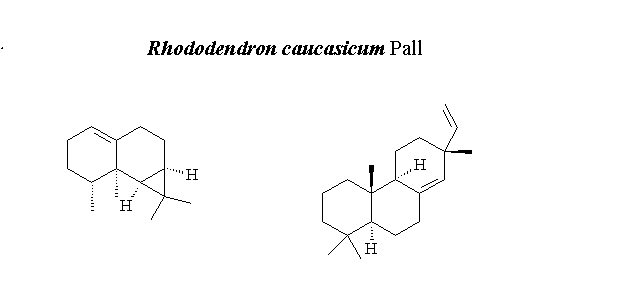JOURNAL 952
Records of Natural Products
Year: 2019 Issue: 4 July-August
p.316 - 323
Viewed 3916 times.
-
Seda Fandaklı

-
Nurettin Yaylı

-
Nuran Kahriman

-
Emel Uzunalioğlu

-
Nevin Ulaş Çolak

-
Sercan Yıldırım

-
Ahmet Yasar

GRAPHICAL ABSTRACT

ABSTRACT
The aim of this research was to investigate the effect of different extraction methods and chemical composition of the essential oil and solid-phase microextraction (SPME) from Rhododendrum caucasium Pall. The volatiles of R. caucasicum have been isolated by hydro distillation (HD) and SPME. The compositions of the volatiles were characterized by GC-FID/MS. A total of twenty-five and thirty-one compounds were identified constituting over 89.25%, and 90.33% of volatiles obtained with HD and SPME, respectively. The main volatile constituents of R. caucasicum were found to be calarene (46.13% (HD) and 54.91% (SPME)) and sandaracopimaradiene (25.93% (HD) and 8.16% (SPME)). Furthermore, the obtained essential oil (EO) and solvent extracts (n-hexane and methanol) of R. caucasicum were tested against the following nine bacteria: Escherichia coli, Yersinia pseudotuberculosis, Pseudomonas aeruginosa, Enterococcus faecalis, Staphylococcus aureus, Bacillus cereus, Mycobacterium smegmatis, Candida albicans, and Saccharomyces cerevisiae. The EO showed moderate antimicrobial activities with the inhibition zone from 6 to18 mm against E. faecalis, S. aureus, B. cereus and M. smegmatis, respectively. Methanol extract gave better antimicrobial activity against the P. aeruginosa, E. faecalis, S. aureus, and B. cereus with the almost 15 mm inhibition zones.
KEYWORDS- Rhododendron caucasicum; hydrodistillation; SPME; essential oil; antimicrobial activity; GC-FID/MS.